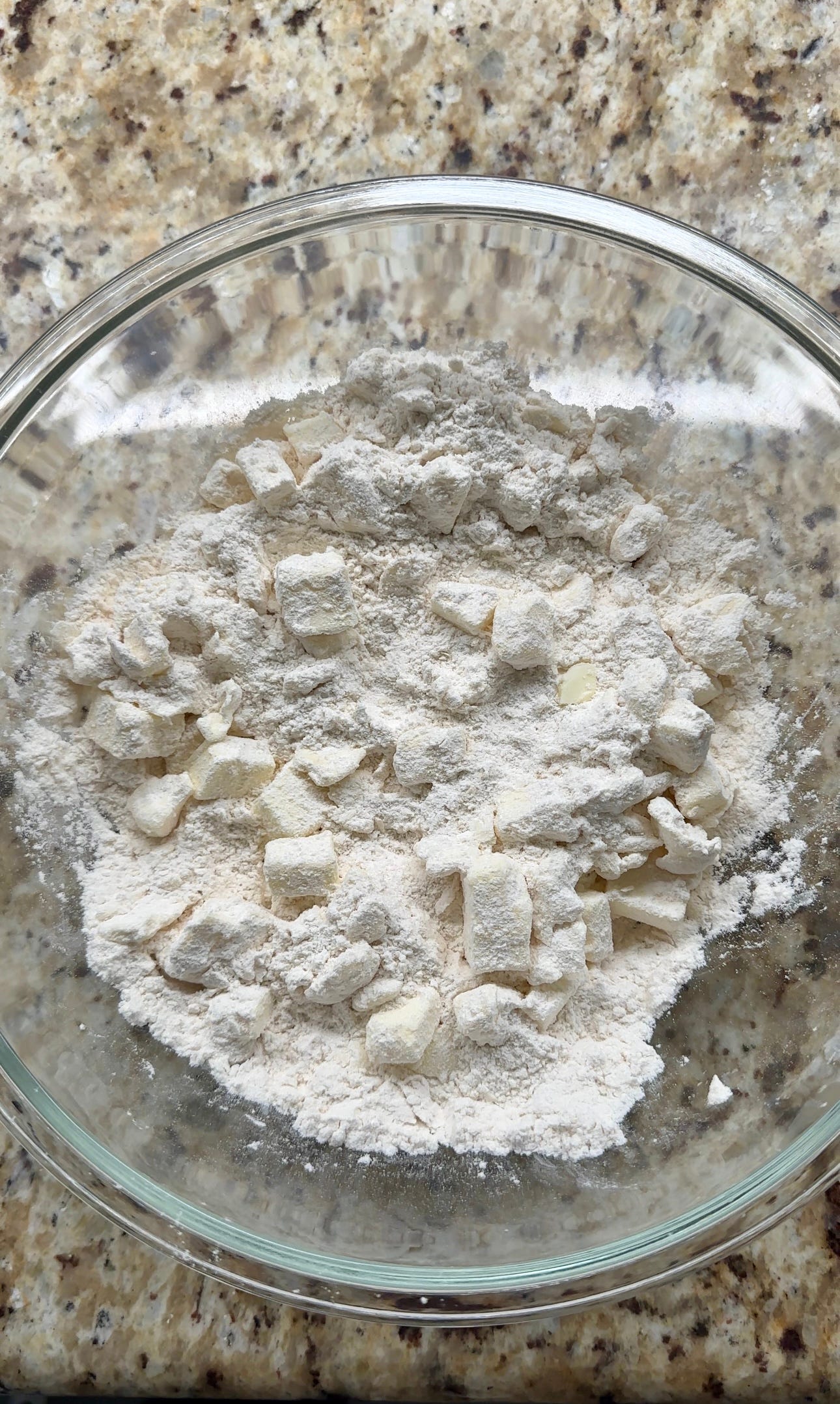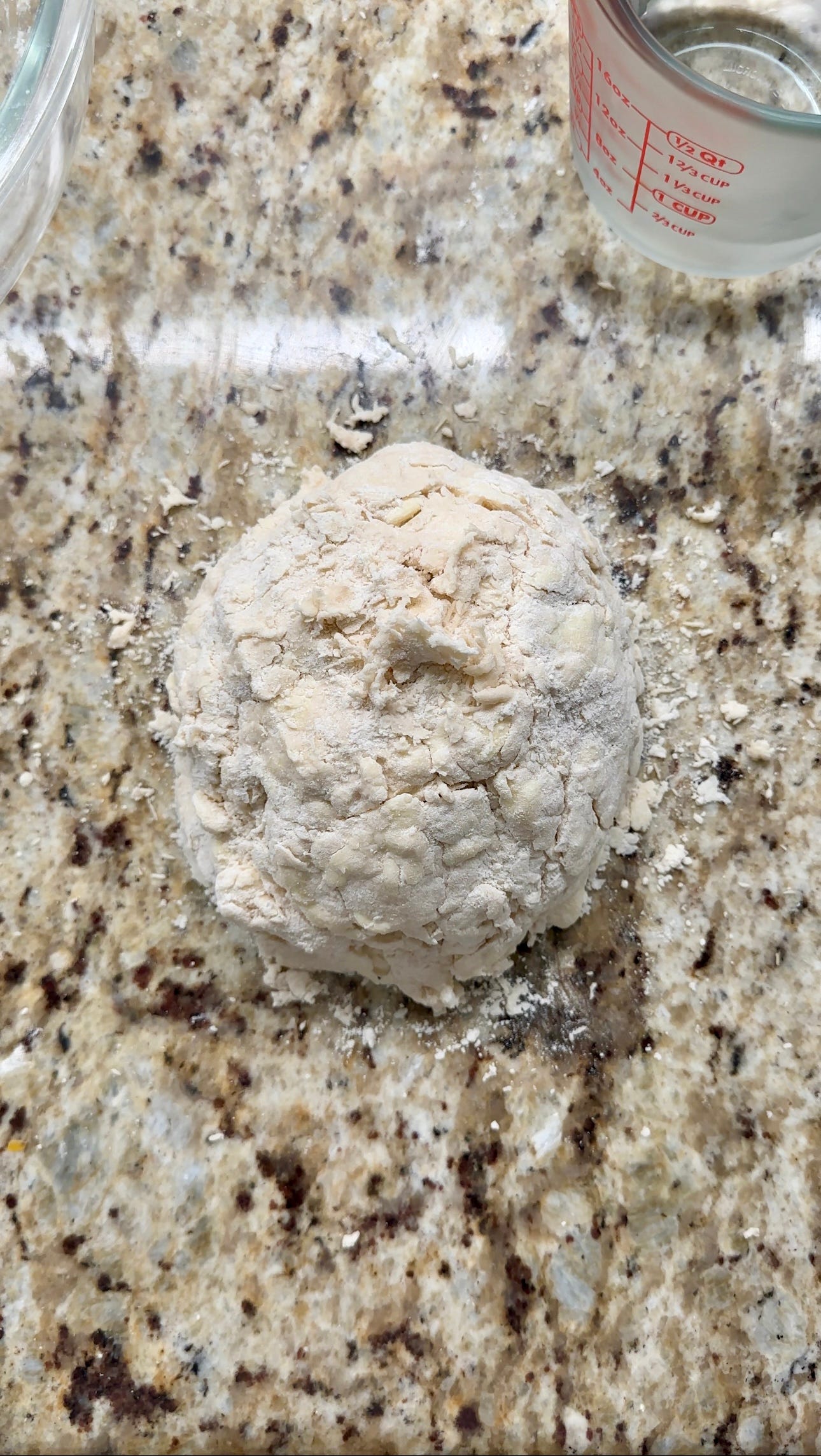Notes before beginning: I strongly believe that pie tastes best when the dough has had a chance to rest and set up for 12 hours at least prior to baking! Here is why! Rest helps your pie dough relax and hydrate. (just like humans! we are better versions of ourselves when we rest and drink water!) So letting your dough rest for at least 12 hours, means the dough is less elastic (aka easier to roll out) and has a greater chance of puffing up and becoming flaky when baked! Please give yourself enough time to make this dough and let it rest before making your pie.
What you need:
2½ cups (312.5 g) all-purpose flour
3½ tsp (14.5 g) sugar
1 tsp (6 g) salt
1 cup (227 g) cold unsalted butter, cubed
½ cup (120 ml) cold water, plus more to help with the crumbies
What to do:
1.To begin, place the flour, sugar, salt in a large bowl. Give everything a gentle mix.
2. Cut cold butter into cubes and then add half to flour mix. Make sure every piece of butter is coated in flour. Then pinch each piece so that it flattens. This takes some time, but the end result will be a tender/flaky pie crust! Mix and incorporate every pinched piece of butter. Add the second half of the butter and repeat the process. The mix will look crumbly and cornmeal like when you're done.
3. One tbsp at a time, pour water into the mix. Give the mix a stir after each tbsp of water. At this point, after a few tbsps, I like to use my hands to start pulling the dough together. I try to use only 1/2 cup of water, but you will likely need an additional tsp or two to bring everything together. If you find your dough is coming together with ease, and not crumbling, then stop adding water, and pour your dough onto a floured surface. If your dough is too crumbly, add one tsp of water at a time and pull the dough together - note it will be shaggy and slightly crumbly- thats ok!
4. Pull your dough into a rectangular or disc, then cut into thirds. Stack the thirds on top of each other and form into a disc again. This method helps create flaky layers! Once you have formed the disc, cut the disc in half and shape each side into its own disc (you will now have two discs). Wrap each disc tightly in plastic wrap. Note: if your dough feels and looks a little crumbly, you can press the loose crumbs into the dough as you wrap it. They will hydrate into your dough in the fridge as your dough rests. Chill both discs for at least 12 hrs, overnight preferred! Note: One disc, when rolled out serves as the base or top to a 9 inch pie. Together, two discs can serve as the top and bottom to a dutch style or lattice pie in a 9 inch pan!
*Once your dough discs have rested and you are ready to bake, you must take them out of the fridge. Before you start rolling out the dough, allow the disc(s) to sit outside of the fridge for about 15-20 minutes. We want cold dough, but soft enough to roll out. You can follow my latest apple slab pie recipe here for more baking deets!
FAQ’s
Q: Why do I need cold ingredients?
Cold ingredients (especially butter) are critical to a successful, flaky pie crust. When cold butter melts in the oven, it releases steam, which creates air pockets and flakiness in your pie, its magical! If the butter is too warm, it will blend into the flour, resulting in an unpleasant, tough crust.
Q: Why does my crust shrink?
Ive seen this happen in both the prep and baking stage. When the crust shrinks, its usually means the dough has been overworked, or the dough hasn’t had enough rest time. In my experience, its usually because I overworked the dough. This happens when I roll out my dough, cut the shapes that I need, then try reshaping/rolling the dough out again… then the dough becomes tough and starts to shrink. My advice- roll out your dough only once if you can help it. If you need to reshape or roll it out again, first place it in the fridge to chill/rest for at least 20-30 minutes.
Q: What if my dough has cracks in it?
This happens to me all the time! The best way to seal up the crack is to dab that area with some water and then pepper a small amount of flour on top and rub it in. Its like a patch! You can resume rolling and shaping as needed after you rub the crack with water and flour!











